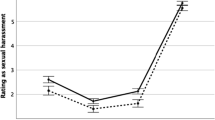Summary
The overall findings suggest that while attitudes and perceptions of sexual harassment are related, they also differ, in that attitudes require value judgments to be made of behavior. This explains the high relationship between attitudes to sexual harassment and attitudes regarding gender role stereotypes. Sexist attitudes are associated with acceptance of sexual harassment. The impact of age and occupation on attitudes suggest that high school students adhere to gender role stereotypes and have a high tolerance of sexual harassment. However, this group’s lack of experience in the world and, consequently, their limited exposure to attitudes that may challenge their current scripts and schemas, may be responsible for these findings.
Similar content being viewed by others
References
Antill, J. K., Cunningham, J. D., Russell, G., & Thompson, N. L. (1981). An Australian sex role scale.Australian Journal of Psychology, 33, 169–183.
Australian Human Rights and Equal Opportunity Commission. (1984).The sex discrimination act 1984: Sexual harassment—knowing your rights. Australia: Australian Human Rights and Equal Opportunity Commission.
Baker, D. D., Terpstra, D. E., & Cutler, B. D. (1990). Perceptions of sexual harassment: A re-examination of gender differences.The Journal of Psychology, 124, 409–416.
Bartling, C. A., & Eisenman, R. (1993). Sexual harassment proclivities in men and women.Bulletin of the Psychonomic Society, 31, 189–192.
Burt, M. R. (1980). Cultural myths and supports for rape.Journal of Personality and Social Psychology, 38, 217–230.
Charney, D. A., & Russell, R. C. (1994). An overview of sexual harassment,American Journal of Psychiatry, 151, 10–17.
Feltey, K. M., Ainslie, J. J., & Geib, A. (1991). Sexual coercion attitudes among high school students—the influence of gender and rape education.Youth and Society, 28, 229–350.
Gagnon, J. H. (1973). Scripts and the coordination of sexual conduct.Nebraska Symposium on Motivation, 21, 27–59.
Gagnon, J. H., & Simon, W. (1973).Sexual conduct: The social sources of human sexuality. New York: Aldine Publishing Company.
Jones, T. S., & Remland, M. S. (1992). Sources of variability in perceptions of and responses to sexual harassment.Sex Roles, 27, 121–142.
Lott, B., Reilly, M., & Howard, D. R. (1982). Sexual assault and harassment: A campus community case study.Signs: Journal of Women in Culture and Society, 8, 296–319.
Marsh, H. W. (1987). Masculinity, femininity and androgyny: Their relations with multiple dimensions of self-concept.Multivariate Behavioral Research, 22, 91–118.
Mazer, D. B., & Percival, E. F. (1989). Ideology or experience? The relationships among perceptions, attitudes, and experience of sexual harassment in university students.Sex Roles, 20, 135–147.
Mischel, W. (1966). A social learning view of sex differences in behavior, in E. E. Maccoby (Ed.),The development of sex differences. Palo Alto, CA: Stanford University Press.
Murrell, A. J., & Dietz-Uhler, B. L. (1993). Gender identity and adversarial sexual beliefs as predictors of attitudes toward sexual harassment.Psychology of Women Quarterly, 17, 169–175.
Nelson, C., & Keith, J. (1990). Comparisons of female nd male early adolescent sex role attitude and behavior development.Adolescence, 15, 183–204.
Popovich, P. M., Gehlauf, D. N., Jolton, J. A., Somers, J. M., & Godinho, R. M. (1992). Perceptions of sexual harassment as a function of sex of rater and incident form and consequence.Sex Roles, 27, 609–625.
Powell, G. N. (1986). Effects of sex role identity and sex on definitions of sexual harassment.Sex Roles, 14, 9–19.
Pryor, J. B., Lavite, C. M., & Stoller, L. M. (1993). A social psychological analysis of sexual harassment: The person situation interaction.Journal of Vocational Behavior, 42, 68–83.
Reilly, M. E., Lott, B., Caldwell, D., & DeLuca, L. (1992). Tolerance for sexual harassment related to self-reported sexual victimization.Gender and Society, 6, 122–138.
Reilly, M. E., Lott, B., & Gallogly, S. M. (1986). Sexual harassment of university students.Sex Roles, 15, 333–358.
Roscoe, B., Strouse, J. S., & Goodwin, M. P. (1994). Sexual harassment: Early adolescents’ self-reports of experiences and acceptance.Adolescence, 29, 515–523.
Rubin, L. J., & Borgers, S. B. (1990). Sexual harassment in universities during the 1980s.Sex Roles, 23, 397–411.
Tata, J. (1993). The structure and phenomenon of sexual harassment: impact of category of sexually harassing behavior, gender, and hierarchical level.Journal of Applied Social Psychology. 23, 199–211.
Terpstra, D. E., & Baker, D. D. (1986). A framework for the study of sexual harassment.Basic and Applied Social Psychology, 7, 17–34.
Villemez, W. J., & Touhey, J. C. (1977). A measure of individual differences in sex stereotyping and sex discrimination: The ‘macho’ scale.Psychological Reports, 41, 411–415.
Zaitchik, M. G., & Mosher, D. L. (1993). Criminal justice implications of the macho personality constellation.Criminal Justice and Behavior, 20, 227–239.
Author information
Authors and Affiliations
Rights and permissions
About this article
Cite this article
Foulis, D., McCabe, M.P. Sexual harassment: factors affecting attitudes and perceptions. Sex Roles 37, 773–798 (1997). https://doi.org/10.1007/BF02936339
Issue Date:
DOI: https://doi.org/10.1007/BF02936339




